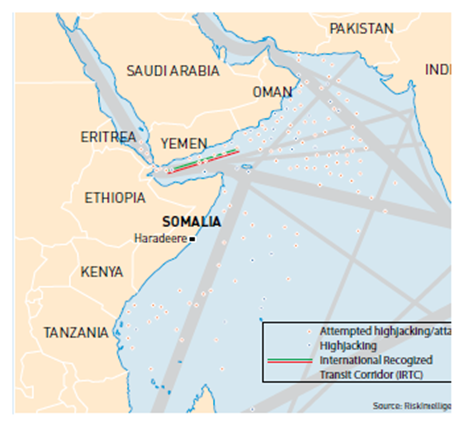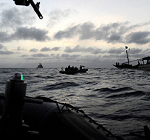Piracy has arrived as a subject of Indian policy-making. The urgency with which it needs to be implemented was highlighted earlier this month, when India’s National Security Advisor Shivshankar Menon addressed a high-level global meeting in St. Petersburg to specifically discuss ways and means of fighting piracy. As Menon discussed measures India has taken to combat piracy, he also mentioned that 43 Indian sailors were at that moment held hostage by Somali pirates. “With over 237 hijacking attempts in 2011, piracy is no longer sporadic attacks by small, unconnected criminal groups,” Menon unambiguously stated. “Piracy today is a growing industry and a significant threat to maritime shipping and to global commerce.”
The operative phrase is “growing industry.” Globally, security officials and shippers laud the diminishing of piracy in the eastern Indian Ocean area, specifically along the critically important Straits of Malacca and South China Sea. This is on account of multi-nation naval patrolling and, alongside, addressing the root causes of demographies susceptible to piracy as an occupation. However, piracy and hostage-taking remains undiminished in the Western African coast abutting Nigeria and Benin, and absolutely thrives off the East African coast near Somalia and the Gulf of Aden—a region of great importance for world shipping as it straddles the Sea Lane of Communication that connects the Mediterranean and Arabian seas through the Suez Canal and the Red Sea. A little further to the east is the Persian Gulf; nearly 90% of India’s oil imports move through this zone, specifically through the Straits of Hormuz.
India’s concern with piracy is, and will, in the foreseeable future, remain three-fold:
One is the direct effect of piracy. The threat to Indian-owned shipping, India-oriented cargos through ships owned by flags of other nations, and to Indian citizens directly. As Menon emphasized in his St. Petersburg talk, nearly an eighth of “global seafarers” are of Indian origin. (Increased insurance costs for shipping, cargo and personnel travelling through high-risk corridors are a corollary.)
The second factor is how to deal with piracy and hostage-taking on the high seas, which brings with it a combination of preventive naval reach, prosecutorial legal reach, and geopolitical reach by working the United Nations, and other multi-lateral and bilateral systems to diminish the need to take to piracy; make extradition of pirates easier; and make multi-nation communication, patrolling, and interdiction efforts more robust.
The third factor, increasingly seen as being a fulcrum-factor, is the squeezing and shutting down of what has, over the past five years or so, rapidly coalesced into an organized industry. India’s national security advisor quoted figures which estimated that $160 million paid to pirates as ransom in 2011. “This money not only finances piracy but leads to money laundering,” he asserted. “We need to trace and shut down the networks operating in support of piracy, monitoring and punishing the security companies and financial operators who work in the background and enable and abet piracy.” He specifically pointed to the “trans-national dimensions” of Somali piracy, and re-flagged an on-going global alarm that pirates appeared to possess data on the movement of targeted vessels and on-board security arrangements.
Established and continuing research points to a seamless method of pirates reaching ship-owners, and funds in cash — ransom — finding its way to designated places and people. Lifestyles led by pirate-lords in sanctuaries along the Somali coast are the stuff of legend. There is talk of ransom money fuelling investment in several African countries, and pushing up real-estate prices in their capital cities and resorts. More intriguing is the manner in which acts of piracy are believed to be underwritten by financiers across continents and profits from ransom then shared along the importance of the food-chain, as it were. Specific security concerns for India from such organized crime include money-laundering and counterfeit currency—and also include Al-Qaeda derivatives and splinters secure, especially in the radical Islamist-controlled parts of southern Somalia, and Yemen, that are suspected of using piracy to generate funds and followers.
This collective danger, both real and potential, has now come further east, with expansion last year of the definition of the high risk area related to piracy. It has expanded from the 65th meridian east—a line on the map that extends south from the Balochistan region of Pakistan into the Arabian Sea—to the 78th meridian east, which covers the entire west coast of India; and effectively covers the sea lanes that travel to and skirt Sri Lanka, along which moves a vast chunk of Indian and global merchant traffic. This risk and the mitigation of it is all the more immediate for India – using the United Nations Convention on the Law of the Sea, it has applied to extend its exclusive economic zone from 200 nautical miles (370 kilometers) off the coast, to 350 nautical miles (647.5 kilometers).
With greater territory will arrive greater responsibility.

At this point, Indian reach is relatively limited in the overall scheme of things, though attempts are on-going to make legal, diplomatic and security initiatives more robust. Part of it is achieved by India directly participating in patrolling operations off Somalia as part of a multinational task force. India has deployed ships with marine commandos and helicopters since 2008; escorted more than 2,000 ships along the high-risk corridor (the Internationally Recommended Transit Corridor, which is sometimes referred to as Internationally Recognized Transit Corridor) in the Gulf of Aden over the past three years. About a tenth of these have been Indian flag-carriers. Such escorting has passed without incident. The Indian Navy too, has actively prevented several dozen acts of piracy. (This is in addition to the Indian Navy energizing and expanding its “blue water” capabilities for the strategic projection of force across the Indian Ocean area, and along with the coast guard, ensuring real-time patrolling to safeguard its already vast exclusive economic zone that exceeds 2 million square kilometers.)
A fallout — at this time an outright complication — is the incarceration of over a hundred Somali pirates in Indian jails. In the absence of specific anti-piracy law in India, various aspects of the Indian Penal Code and Code of Criminal Procedure are being applied to these pirates, with confusing results. To redress the situation and plug legal loopholes, India’s Minister of External Affairs, S.M. Krishna, formally introduced the Piracy Bill 2012 in Parliament on 21March this year. Covering acts of piracy against ships on the high seas as well as within India’s exclusive economic zone, the designated penalty for acts of piracy in the Bill is emphatic. “Whoever commits an act of piracy shall be punished with imprisonment for life,” the Bill proposes, “except where the accused has caused death in committing the act of piracy or attempt thereof in which case he may be punished with death…” Any attempt to commit piracy or “unlawful attempt intended to aid, abet, counsel or procure for the commission of an offence of piracy” will attract a maximum of 14 years of jail term in addition to fines. (There is as yet no globally acceptable legal framework for anti-piracy action. In some cases, signatories to United Nations conventions against piracy are yet to initiate specific anti-piracy laws in their territories.)
There is greater push in the diplomatic arena. While the Indian position calls for an UN-led effort to combat and curb piracy, it has tracked with interest several other initiatives. A major initiative was the 23rd February 2012 London Conference on Somalia held at Lancaster House. It was attended by US Secretary of State Hillary Clinton, UK Prime Minister David Cameron, UN Secretary General Ban-ki Moon, and several high-level representatives from east African nations. Of particular note was the presence of leaders from Somalia’s Transitional Federal Government as well as of some breakaway regions, including the pirate havens of Puntland and Somaliland.
The conference spent considerable time on piracy issues, trying to work on strategies and mechanisms that ranged from peace deals in this strife-torn region that has emerged as the cradle of 21st century piracy, to development assistance to minimize the need for impoverished fisher-folk to take to piracy, and legal issues that include extradition, incarceration and prosecution of pirates. In early June a major international conference on Somalia in Istanbul followed this effort. And over 27-28 June 2012, United Arab Emirates will host in Dubai its second international “public-private counter-piracy conference” as the organizers bill it, formally titled, “A Regional Response to Maritime Piracy: Enhancing Public-Private Partnerships and Strengthening Global Engagement”.
New Delhi will have its eyes and ears — and views — in such places. Alongside, as its national security advisor has stated in several forums, it will continue to aid efforts such as the African Union Mission in Somalia, or AMISOM, sometimes described as the “mainstay of security-related operations in Somalia” to which Government of India has thus far contributed $3 million. This, in addition to UN resolutions securing and expanding the mandate of AMISOM would, as Mr. Menon stated in St Petersburg, “constitute helpful steps towards sanitizing the Somali coastline and deprive Al-Shabaab [a Somali jihadist group] of revenues earned from port facilities and the export of charcoal. Further steps are necessary to effectively sanitize the Somali coastline and ensure that the Somali pirates are not able to use their bases on the coast to launch attacks.”
All of this will collectively add to anti-piracy efforts—as, surely, will focus on human and socio-political development of the entire Horn of Africa.
But the Third Factor, the unseen yet emphatically-heard puppet-meisters of piracy, will likely remain elusive. It is to tracking this network that India’s anti-piracy energies must also focus. As the current chair of the Indian Ocean Rim Association for Regional Co-operation, India can play a leadership role in this effort.
Sudeep Chakravarti writes on socio-political issues and conflict in South Asia. He is the author of Red Sun: Travels in Naxalite Country and the just-published Highway 39: Journeys through a Fractured Land. Chakravarti was earlier associated in a senior capacity with several major Indian and global publications where he focused on political economy, corporate affairs, and India’s overseas relations.
This article was exclusively written for Gateway House: Indian Council on Global Relations. You can read more exclusive content here.
For interview requests with the author, or for permission to republish, please contact outreach@gatewayhouse.in.
© Copyright 2012 Gateway House: Indian Council on Global Relations. All rights reserved. Any unauthorized copying or reproduction is strictly prohibited.
Image source: International Order at Sea: Anti-Piracy and Humanitarian Operations, Jo Inge Bekkevold, Robert S Ross (eds), Norwegian Institute for Defence Studies, 2012.


